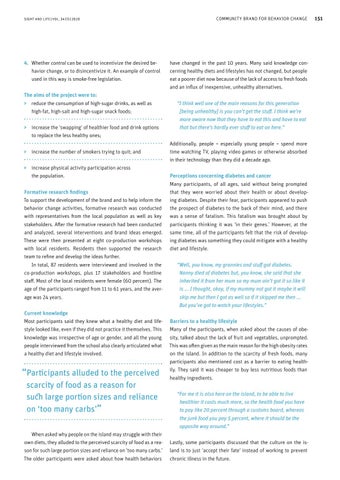SIGHT AND L IFE | VOL. 34 (1) | 2020
4. Whether control can be used to incentivize the desired behavior change, or to disincentivize it. An example of control used in this way is smoke-free legislation. The aims of the project were to: > reduce the consumption of high-sugar drinks, as well as high-fat, high-salt and high-sugar snack foods; > increase the ‘swapping’ of healthier food and drink options to replace the less healthy ones; > increase the number of smokers trying to quit; and > increase physical activity participation across the population. Formative research findings To support the development of the brand and to help inform the behavior change activities, formative research was conducted with representatives from the local population as well as key stakeholders. After the formative research had been conducted and analyzed, several interventions and brand ideas emerged. These were then presented at eight co-production workshops with local residents. Residents then supported the research team to refine and develop the ideas further. In total, 87 residents were interviewed and involved in the co-production workshops, plus 17 stakeholders and frontline staff. Most of the local residents were female (60 percent). The age of the participants ranged from 11 to 61 years, and the average was 24 years. Current knowledge Most participants said they knew what a healthy diet and lifestyle looked like, even if they did not practice it themselves. This knowledge was irrespective of age or gender, and all the young people interviewed from the school also clearly articulated what a healthy diet and lifestyle involved.
“Participants alluded to the perceived scarcity of food as a reason for such large portion sizes and reliance on ‘too many carbs’” When asked why people on the island may struggle with their own diets, they alluded to the perceived scarcity of food as a reason for such large portion sizes and reliance on ‘too many carbs.’ The older participants were asked about how health behaviors
COMMUNITY BRAND FOR BEHAVIOR CHANGE
have changed in the past 10 years. Many said knowledge concerning healthy diets and lifestyles has not changed, but people eat a poorer diet now because of the lack of access to fresh foods and an influx of inexpensive, unhealthy alternatives. “I think well one of the main reasons for this generation [being unhealthy] is you can’t get the stuff. I think we’re more aware now that they have to eat this and have to eat that but there’s hardly ever stuff to eat on here.” Additionally, people – especially young people – spend more time watching TV, playing video games or otherwise absorbed in their technology than they did a decade ago. Perceptions concerning diabetes and cancer Many participants, of all ages, said without being prompted that they were worried about their health or about developing diabetes. Despite their fear, participants appeared to push the prospect of diabetes to the back of their mind, and there was a sense of fatalism. This fatalism was brought about by participants thinking it was ‘in their genes.’ However, at the same time, all of the participants felt that the risk of developing diabetes was something they could mitigate with a healthy diet and lifestyle. “Well, you know, my grannies and stuff got diabetes. Nanny died of diabetes but, you know, she said that she inherited it from her mum so my mum ain’t got it so like it is ... I thought, okay, if my mummy not got it maybe it will skip me but then I got as well so if it skipped me then ... But you’ve got to watch your lifestyles.” Barriers to a healthy lifestyle Many of the participants, when asked about the causes of obesity, talked about the lack of fruit and vegetables, unprompted. This was often given as the main reason for the high obesity rates on the island. In addition to the scarcity of fresh foods, many participants also mentioned cost as a barrier to eating healthily. They said it was cheaper to buy less nutritious foods than healthy ingredients. “For me it is also here on the island, to be able to live healthier it costs much more, so the health food you have to pay like 20 percent through a customs board, whereas the junk food you pay 5 percent, where it should be the opposite way around.” Lastly, some participants discussed that the culture on the island is to just ‘accept their fate’ instead of working to prevent chronic illness in the future.
151
